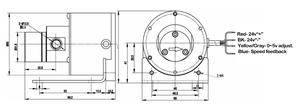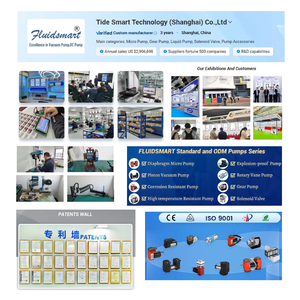
All categories
Featured selections
Trade Assurance
Buyer Central
Help Center
Get the app
Become a supplier

(1417 products available)


























Acom
pumps play a crucial role in ensuring the movement of water in the tank to keep fish alive. They consist of several components that assist in making the pumps functional. Here are some commonly known aquarium pump parts.
Sizes and flow rates
Aquarium pumps come in different sizes and flow rates. Small pumps can move a little bit of water, like 240 liters per hour. Bigger pumps can push more water, like 1,800 liters per hour or even higher. Businesses should have pumps that are good for small tanks and some that are strong enough for big reef tanks.
Noise levels
The pump's noise levels are important for people who keep fish at home or in public places like hospitals. Pumps should be under 40 decibels so they are quiet. Pumps that make more noise than this should be set over 40 decibels but below 50 decibels. Businesses can stock up on two types – the first that is super quiet, and the second that is a little louder but still acceptable for use in homes and other indoor living environments.
Power consumption
Pumps use different amounts of electricity. Small pumps may use around 5 watts. Bigger ones could use 10 to 20 watts. It would be good to carry some that save energy well, using 5 watts or less, and others that use a bit more but are still efficient, too.
Connection types
There are different ways to connect a pump to a filter or hose. Some pumps have a round plug called a barbed fitting. Others use a smooth fitting that is called a push fitting. Businesses should have pumps with both kinds of connections so customers can select the one that works best for their tank setup.
The aquarium pump must be cleaned for it to perform its intended function efficiently and prolong its lifespan. Cleaning it regularly also keeps the water fresh and free from pollutants that might affect the health of the aquatic animals and plants. Here are some maintenance tips:
Turn Off the Power Source:
Before doing any cleaning, it would be safe to disconnect the pump from its power supply.
Remove the Pump:
Prior to cleaning, take out the aquarium air pump parts carefully. While doing this, it is important to check for cracks and any debris that could stop normal functionality.
Clean the Filter:
Cleaning the filter is important so as to keep the air supply flowing freely. Buyers can soak it in diluted bleach before rinsing it under running water.
Clean the Pump:
Using a small brush or soft cloth, wipe off any debris or buildup on the surfaces of the pump. If there are stubborn deposits, buyers can use some vinegar and a soft cloth to loosen and wipe them off. Never immerse the pump in water.
Replace the Pump:
Once the pump is thoroughly dried, put it back inside the aquarium. While doing this, ensure that all the connection points are firm and secure.
Aquarium pumps are used in different scenarios, including in the following industries.
Fish farming industry
An aquarium air pump is used in the fish farming industry to create a consistent-water-flow system that enables fish to breathe. It plays an integral role in achieving effective-oxygen-diffusion throughout the fish pond or tank. This helps maintain a healthy habitat to promote fish growth and survival.
Water fountain and waterfall construction
Aquarium pumps are commonly used in the construction of water fountains and waterfalls. This applies either in commercial settings or at residential homes. It helps propel water to create flowing and spraying water patterns. The functionality and reliability of an aquarium pump are crucial for the seamless operation of a water feature.
Aquarium maintenance service
Aquarium pumps play a crucial role in the maintenance of aquariums. This applies to both commercial aquariums in public places and private small-scale aquariums in homes. A well-maintained aquarium must have a functioning pump that will ensure the tank's water is constantly circulated. Furthermore, oxygen will be diffused throughout the tank to support the aquatic life.
Aquaculture industry
The aquaculture industry refers to the farming of aquatic organisms in a controlled environment. This includes fish, shellfish, and seaweed. It can also extend to the breeding of marine animals in the open sea, lakes, or rivers. An aquarium air pump provides the necessary oxygen to support the growth and development of aquatic plants and animals. It boosts the growth of commercially-reliable species like shrimp and fish. Proper aeration supported by the pumps improves feeding efficiency and reduces mortality rates.
Drinking water treatment facilities
Aquarium pumps are commonly used in drinking water treatment facilities. The role of the pump in water treatment facilities is to aerate the water. This helps in the removal of unpleasant tastes and odors.
When choosing aquarium pump accessories, a combination of aesthetic and functional considerations may help to create a healthy, beautiful aquatic environment. Here are some things to consider when selecting aquarium pump parts:
Compatibility:
The first thing people will consider is whether the pump parts are compatible with the existing pump. This may include factors such as size, connection mechanism, and functionality.
Quality:
Aquarium owners will likely want to buy durable aquarium pump parts rather than those that break or wear out quickly. Because of this, they will likely consider the materials used to make the products, their craftsmanship, and the reputation of the manufacturers. This will help them select products that are sturdy and long lasting.
Noise Level:
Aquarium pumps must ensure good water circulation and be quiet. People who own aquariums know that a quiet pump helps to create a peaceful environment and reduces noise pollution at home and in the office.
Flow Control:
Aquarium owners understand that different aquatic life requires distinct water flow rates. For instance, reef aquariums usually need gentle water movement, while tanks that house fish that swim fast need strong currents. As a result, they will look for pump parts that enable them to adjust the flow rates to suit their aquatic needs.
Aesthetics:
Pump parts also come in various designs, shapes, and colors. Those who wish to create a beautiful aquatic environment can use aesthetically pleasing pump parts that complement the overall decor of the aquarium.
Cost:
Cost is an important factor when choosing aquarium pump parts. However, aquarium owners should remember that the selected parts will affect the health and wellbeing of the aquatic life. For this reason, it may be wise to prioritize quality and compatibility instead of selecting the cheapest option.
Q1: What are the common materials of aquarium pump parts?
A1: The aquarium pump components must be compatible with aquatic environments. Therefore, stainless steel, ceramic, silicone, glass, and plastic materials are typical choices.
Q2: What is the life expectancy of aquarium pump parts?
A2: The lifespan of aquarium pump components depends on various factors, including material, quality, usage frequency, maintenance, etc. Generally, high-quality pump parts can last for several years.
Q3: Do worn aquarium pump parts affect the performance of the whole pump?
A3: Yes, worn aquarium pump components can affect the performance of the entire pump, leading to a decline in filtration and oxygen supply abilities.
Q4: How to tell if the aquarium pump parts need to be replaced?
A4: If there are distinctive scratches or damages on the pump parts, the performance of the pump declines, or the noise increases, it is better to consider replacing them. Otherwise, the aquarium will be impacted.